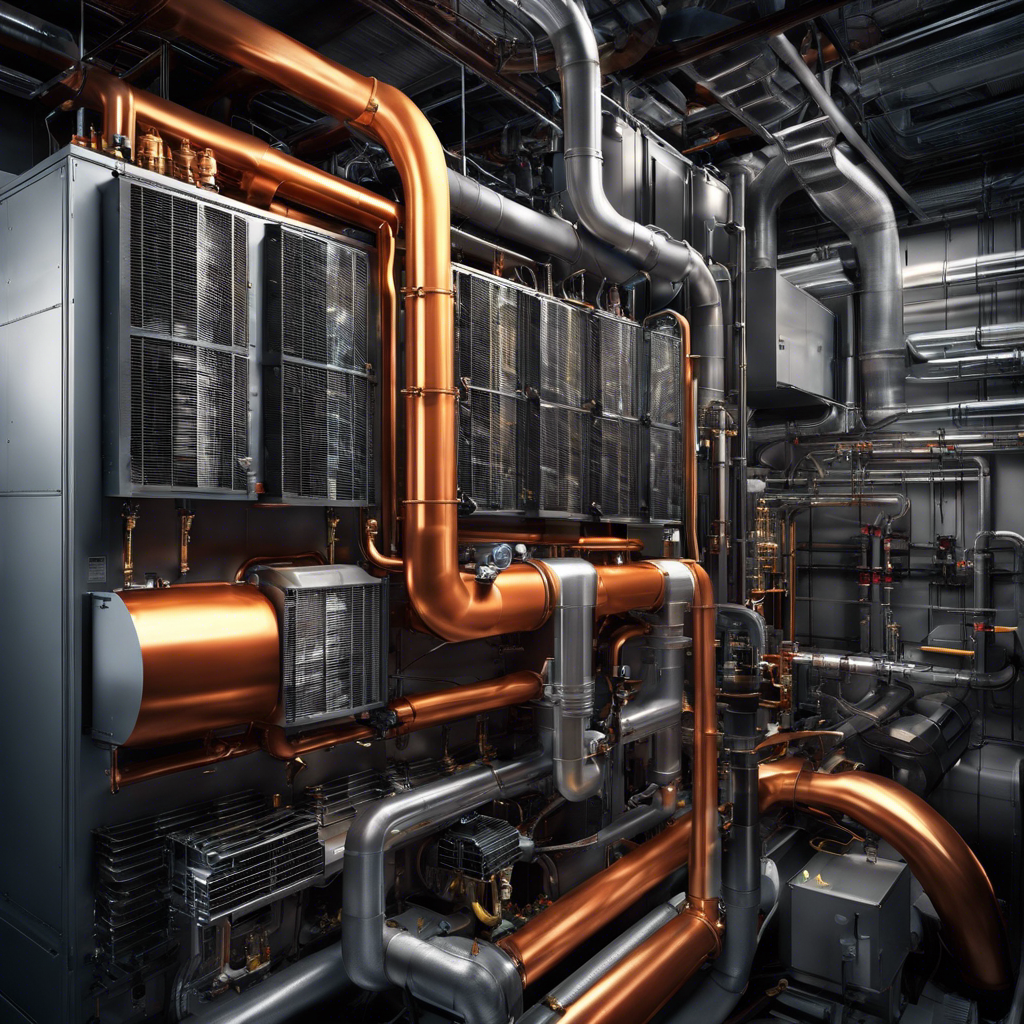Welcome to ‘The Anatomy of an HVAC System: Essential Components Explained.’ In this enlightening article, we will delve into the intricate world of HVAC systems, unravelling the fundamental components that comprise these marvels of modern technology.
Whether you are a homeowner seeking to understand the inner workings of your HVAC system or an aspiring professional in the field, this resource will provide you with the knowledge you seek.
Through a comprehensive exploration of key components such as thermostats, furnaces, heat exchangers, evaporator coils, condensing units, refrigerant lines, ductwork, and return/supply registers, we will shed light on their functions, significance, and potential issues that may arise.
By familiarizing yourself with these vital elements, you will be better equipped to ensure the optimal performance and longevity of your HVAC system.
Join us on this educational journey as we unravel the complexities of HVAC systems and empower you with the insights needed to foster a sense of belonging in this ever-evolving industry.
Key Takeaways
- The thermostat is the control center for regulating temperature and allows for adjusting temperature settings.
- The furnace and blower motor work together to produce and distribute heated air throughout the home, ensuring efficient and consistent heating.
- The heat exchanger facilitates heat transfer and is responsible for warming the air in the furnace and absorbing heat during the cooling season.
- The evaporator coil plays a crucial role in the cooling process by absorbing heat from indoor air and cooling it. Regular maintenance and cleaning are essential for its optimal performance.
- The condensing unit expels heat absorbed from indoor air to the exterior and works in conjunction with the thermostat to regulate temperature. Regular maintenance is necessary for its optimal performance.
Thermostat
The thermostat is a crucial component of an HVAC system, serving as the control center for regulating temperature and managing heating and cooling functions. It is the interface through which users interact with the system, allowing them to adjust temperature settings according to their preferences.
The thermostat communicates with other essential components of the HVAC system, such as the indoor evaporator coil, air conditioning unit, heat exchanger, blower motor, condensing unit, and refrigerant lines. By receiving signals from the thermostat, these components work together to maintain the desired temperature in the house.
Programmable thermostat models provide added convenience by allowing users to schedule temperature changes based on their daily routines. With multiple thermostats, zoning is possible, enabling control of different areas in the home independently.
Thus, the thermostat plays a vital role in ensuring comfort, energy efficiency, and air quality in the HVAC system.
Furnace and Blower Motor
The furnace and blower motor are vital components of an HVAC system, working together to ensure efficient and consistent heating by regulating the distribution of heated air throughout the home.
The furnace, which is a key part of the HVAC system, produces heat by burning fuel or using electricity. It contains a heat exchanger that warms the air as it passes through.
The blower motor, on the other hand, is responsible for circulating the heated air through the system. It pulls the air from the furnace and pushes it through the air handler, where it is then distributed to different areas of the home via the ductwork.
The blower motor also plays a crucial role in the air conditioning system, as it is used to distribute cool air during the summer months.
Heat Exchanger
Within an HVAC system, the heat exchanger serves a critical role in facilitating heat transfer without mixing fluids. It is an essential component that ensures the efficient and safe operation of the system.
The heat exchanger is responsible for transferring heat from the combustion chamber to the metal walls, which then heats up the air that is blown over it by the blower motor. This heated air is then circulated back into the home, providing warmth during the heating season.
During the cooling season, the heat exchanger also plays a role in the air conditioning process. The cool air from the indoor space is blown over the heat exchanger, which absorbs the heat and transfers it to the outdoor condenser coil. This allows for the efficient removal of heat from the indoor air.
The heat exchanger is a crucial component in maintaining a comfortable indoor environment and should be regularly inspected and maintained to ensure its proper functioning. It is important to note that a cracked heat exchanger can be a serious safety hazard, as it can lead to carbon monoxide leaks. Therefore, regular maintenance and inspections are necessary to prevent such risks and ensure the safety of the occupants.
The thermostat plays a key role in regulating the temperature and controlling the operation of the heat exchanger within the HVAC system.
Evaporator Coil
To understand the functioning of an HVAC system, it is important to delve into the role of the evaporator coil.
The evaporator coil is a crucial component of the cooling process in an air conditioning unit. Housed in a metal enclosure on the furnace, it acts as a heat exchanger.
The coil is responsible for absorbing heat from the indoor air and cooling it before circulating it back into the living space. This is made possible by the flow of refrigerant through the coil, which undergoes a phase change from a liquid to a gas, absorbing heat in the process.
By cooling the air, the evaporator coil ensures a comfortable indoor environment. Faulty evaporator coils can lead to inadequate heating and cooling, resulting in higher energy bills.
Therefore, regular maintenance and cleaning of the evaporator coil are essential to ensure optimal performance of the HVAC system.
Condensing Unit
The condensing unit, a vital component of the HVAC system, plays a crucial role in expelling heat absorbed from indoor air to the exterior. It is responsible for the heat exchange process that allows the system to cool the hot air circulating throughout the home.
Housed in a metal enclosure, the condensing unit consists of a heat exchanger, refrigerant lines, and a compressor. The refrigerant lines, typically made of copper or aluminum, allow the refrigerant to flow and absorb heat, facilitating the cooling process.
The main unit of the HVAC system, the condensing unit works in conjunction with the thermostat to regulate the temperature and maintain indoor comfort. Regular maintenance is necessary to ensure the optimal performance of the condensing unit, including debris removal and inspection of refrigerant levels.
Frequently Asked Questions
What Are the Basic Components of an HVAC System?
The basic components of an HVAC system include a thermostat, furnace, blower motor, heat exchanger, evaporator coil, condensing unit, and refrigerant lines. These components work together to control temperature, circulate air, and provide heating and cooling in a building.
What Is the Anatomy of a HVAC Unit?
The anatomy of an HVAC unit is comprised of various essential components that work together to provide heating, ventilation, and air conditioning. Understanding HVAC system efficiency, proper maintenance, and the role of thermostats are crucial for optimal performance and comfort.
What Are the 6 Main Components of the Air Conditioning System?
The six main components of an air conditioning system are the thermostat, furnace, blower motor, heat exchanger, evaporator coil, and condensing unit. These components work together to cool the air by utilizing refrigerants and proper insulation, maintaining indoor air quality, and optimizing airflow for energy efficiency.
What Is the Basic Structure of HVAC System?
The basic structure of an HVAC system involves the installation of heating and cooling mechanisms, the importance of HVAC maintenance, energy efficiency, troubleshooting, the lifespan of the system, ductwork, types of filters, thermostats, and common problems and solutions.
Conclusion
In conclusion, understanding the key components of an HVAC system is essential for maintaining its proper functioning.
The thermostat, furnace and blower motor, heat exchanger, evaporator coil, condensing unit, and ductwork all play crucial roles in heating, cooling, and ventilating the space.
By being aware of their function and importance, one can effectively address common issues that may arise and ensure the system’s longevity.
Regular maintenance and prompt repairs are vital for optimal performance and comfort.


